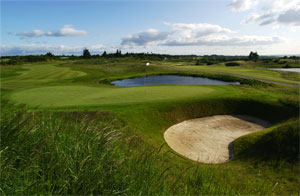Fergus Bisset: A trip to Gleneagles
Fergus travelled to Gleneagles this week to see how the Centenary Course is shaping up with three years to go before it hosts the Ryder Cup.


With just over three years to go before Gleneagles plays host to the 40th Ryder Cup, the resort's Centenary course is continuing to evolve. An extensive programme of improvements is ongoing to bring the layout up to the standard required for the most famous team event in golf. This Monday I travelled south to play the course and to see how things are progressing.
Since it was announced some 10 years ago that the Perthshire resort would welcome the biennial contest in 2014, there has been huge expenditure on the PGA Centenary course to change holes, improve drainage and firm up the greens. The latest move is the trial of a SubAir system (like they have at Augusta) to aerate and remove moisture from the putting surfaces.
The 10th green has been fitted with the system and, if it's a success, the other 17 greens (and the putting green) will all have SubAir fitted. Gleneagles is the first course in the UK to install the underground system.
I think its fair to say that the Centenary has had its critics in recent years. Lee Westwood slated the greens in 2008 and Peter Hedblom was almost as scathing en-route to his victory in 2009.
But the improvement programme has always been long-term and the work done to this point is paying dividends. Despite recent wet weather, the course was dry and the fairways were running. The greens have improved dramatically since last time I visited and, although they were a little slow at this stage, they will be significantly faster by the time of this month's Johnnie Walker Championship.
The SubAir system is working well according to Course and Estate manager Scott Fenwick and they're already recording much lower moisture readings on the 10th green than previously.
The Centenary Course is a great tournament track - long and challenging, yet fair. For the front nine I played solidly and found either fairway or semi-rough from every tee. The greens are sloping but receptive so good shots are rewarded. For those holes I could see how the pros can, and will, return low scores in the Johnnie Walker.
Subscribe to the Golf Monthly newsletter to stay up to date with all the latest tour news, equipment news, reviews, head-to-heads and buyer’s guides from our team of experienced experts.
On the back nine, however, I discovered why this is a seriously difficult course if you're not on top of your game. I started to spray it from the tee and began to visit the deeper cut of rough. I say visit because if your ball strays too far off line you will merely pay the jungle a short visit before realising it's a lost cause. I think this is good though, certainly for the Johnnie Walker. The top pros should be able to find the reasonably generous landing areas and, if they don't, they should be punished for it. I think the set-up is just right for tournament play.
Despite losing my way totally on the run for home, I really enjoyed playing the Centenary Course. It's a layout where you must plot your way round and play the percentages. As mentioned, you can't afford to miss the fairways, but you must also be extremely careful not to miss the putting surfaces in the wrong place. A couple of times I hit reasonable shots just off line in the wrong direction and ended short-sided and facing a hugely difficult pitch. I'm not good when faced with a hugely easy pitch so you can imagine the results on those holes. You can't?... blobs.
I'm looking forward to seeing how the pros negotiate the track from August 25-28 and hearing their thoughts on the layout. With their commitment to learn and improve, the team at Gleneagles is well on course to have the Centenary in amazing shape to stage the 2014 Ryder Cup. I now know that I have to work on my accuracy from the tee if I'm going to make the team for that event, (ok, a couple of other things too, but predominantly accuracy from the tee.)

Fergus is Golf Monthly's resident expert on the history of the game and has written extensively on that subject. He has also worked with Golf Monthly to produce a podcast series. Called 18 Majors: The Golf History Show it offers new and in-depth perspectives on some of the most important moments in golf's long history. You can find all the details about it here.
He is a golf obsessive and 1-handicapper. Growing up in the North East of Scotland, golf runs through his veins and his passion for the sport was bolstered during his time at St Andrews university studying history. He went on to earn a post graduate diploma from the London School of Journalism. Fergus has worked for Golf Monthly since 2004 and has written two books on the game; "Great Golf Debates" together with Jezz Ellwood of Golf Monthly and the history section of "The Ultimate Golf Book" together with Neil Tappin , also of Golf Monthly.
Fergus once shanked a ball from just over Granny Clark's Wynd on the 18th of the Old Course that struck the St Andrews Golf Club and rebounded into the Valley of Sin, from where he saved par. Who says there's no golfing god?